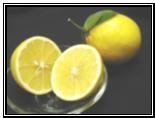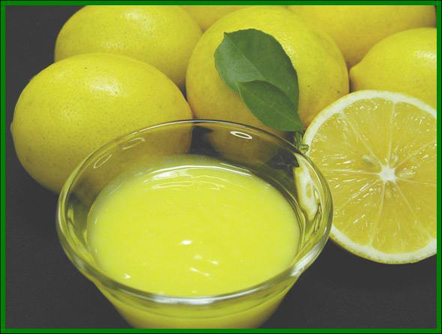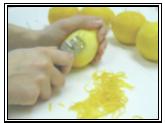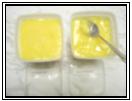Preparing and Preserving Lemon CurdElaine M. D'Sa, Ph.D. |
 |
Making a fruit spread is a delicious way of preserving nature's bounty and adding interest to meals. Several kinds of spreads can be prepared - jams, jellies, conserves, butters and curds. They may supplement the breakfast table or can be used as a topping or filling for tea-time treats - pies, tartlets, meringues, cookies, cakes, muffins, scones and crumpets.
 |
What is a fruit curd? Fruit curds are traditional English spreads, made with fruit juice, butter, eggs, sugar and flavorings. The result is a rich, smooth, melt-in-the-mouth blend that is prized in the best year-round or holiday gift-giving tradition. Increasingly, gourmet gift-shops and food stores catering to epicurean tastes stock several flavors of fruit curds including orange, raspberry, strawberry, nectarine, lime, key lime, mango and even banana curd! The most well-known and sought-after variety, however, continues to be the classic 'lemon curd' - this article will therefore highlight this citrus curd. Making lemon curd at home is sometimes perceived as a challenge to novice cooks, but once the home-food preserver has mastered the art of making this delicacy, its versatility and the demand for this item will be well worth the effort. |
How can I use lemon curd in my meals?
There is no way around it - lemon curd is not something to include in your every day diet, especially if you need to watch fat, sugar and/or calories. But it can add a special touch on many occasions and often only needs to be a small garnish.
- Serve on the side, with other favorite breakfast spreads, together with croissants, muffins, scones or waffles.
- Add a European flair to your breakfast - spread lemon curd on pancakes, crepes or French toast.
- Stir into cream cheese, place in the center of a fruit tray to use as a dip.
- Use as a glaze - spread thinly on cakes.
- Fill pre-baked tartlet shells with lemon curd, top with green sugar sprinkles or a dusting of powdered sugar.
- Spread on thin cake rounds, top with sweetened whipped cream and berries in alternating layers for individual serving-sized parfaits or trifles.
- Sandwich together angel food cake or pound cake layers with lemon curd.
- Fill curd into a pre-baked piecrust, and top with whipped cream.
- Spoon onto ice-cream sundaes as a sauce; top with your favorite add-ons.
- Fill into individual serving-sized meringues, top with a garnish, and serve as dessert.
- Use as a pudding topping, then decorate with maraschino cherries.
- Use as a cheesecake topping, or swirl into cheesecake before baking, for a special effect.
- Stir berry preserves or a whole-berry sauce into individual servings of lemon curd in small dessert glasses for that perfect eye-catching dessert.
The Process
Preparing a lemon curd is an exacting process, requiring special attention to selecting, preparing and assembling the freshest, highest-quality ingredients, blending them in the right order, and carefully cooking to the right temperature, to achieve a homogenous product. Each ingredient (lemon juice, lemon zest, eggs, butter, sugar) plays a unique role in contributing to the texture and flavor of the curd.
Ingredients (see recipe below for quantities): lemon juice (our recipe uses bottled), lemon zest, superfine sugar*, unsalted butter, large eggs.
* If superfine sugar is not available, run granulated sugar through a grinder or food processor for 1 minute, let settle, and use in place of superfine sugar.
Equipment: lemon zester (available at specialty kitchen stores), stainless steel balloon whisk, 1½ quart glass double boiler (the top double boiler pan should be at least 1½-quart volume), or a set of two metal bowls that can fit into one another (the top bowl should preferably have a handle/s that can rest on the rim of the outer bowl); strainer, kitchen thermometer measuring at least up to 180°F, heat-resistant silicone cooking spatula, medium-sized non-reactive (glass or stainless steel) ingredient bowls, 1-quart freezer container.
How to zest a lemon:
Zest is the outer, colored, waxy part of the rind/skin of citrus fruits. Prepare lemon zest just prior to use, for best flavor retention.
| Wash and gently scrub lemons, to remove any waxy coating that may be applied to the fruit. Pat lemons dry. On a cutting board, holding the fruit firmly with one hand, scrape the lemon by dragging the zester across the lemon from top to bottom to obtain strips of zest. Alternately, a grater can be used, but much smaller strips of lemon zest will be obtained. Avoid extracting the underlying bitter membrane (pith) along with the zest. |  |
The Shelf Life
Prepared lemon curd can be frozen for up to 1 year without quality changes when thawed. To thaw, move the container from the freezer to a refrigerator at 40°F or colder for 24 hours before intended use. After thawing, store in the refrigerator in a covered container and consume within 4 weeks.
Additional Tips
- For the lemon zest, choose lemons that are brightly colored, plump and juicy, firm to the touch, with no brown spots, discolorations or blemishes.
- Use good quality butter. Do not use butter substitutes. The butter should be chilled when added to the mixture.
- It is extremely important to lightly but thoroughly beat the mixture after each ingredient is added - this ensures that the mixture being heated is a homogenous one, so that individual ingredients do not harden and separate out during the heating process.
- An even heating process is essential - the boiling water in the lower double-boiler pan or bowl should not touch the mixture pan. Stir constantly to ensure a homogenous mixture.
Freezer Lemon Curd
Yield: Makes one quart or two pint-sized freezer containers
2½ cups superfine sugar*
½ cup lemon zest (freshly zested)
1 cup bottled lemon juice (note that this may contain sulfites)
¾ cup unsalted butter, chilled, cut into approximately ¾" pieces
7 large egg yolks
4 large whole eggs
* If superfine sugar is not available, run granulated sugar through a grinder or food processor for 1 minute, let settle, and use in place of superfine sugar.
Procedure:
Wash freezer container(s) with warm, soapy water. Rinse well and dry. Keep covered or upside down on clean surface to prevent contamination while you make your lemon curd.
Combine the sugar and lemon zest in a small bowl, stir to mix, and set aside about 30 minutes. Pre-measure the lemon juice, prepare the chilled butter pieces and separate eggs to prepare 7 yolks.
| When ready to make the curd, heat water in the bottom pan of double boiler or medium-sized metal bowl, until it boils gently. The water should not boil vigorously or touch the bottom of the top double-boiler pan or bowl in which the curd is to be cooked. Steam produced will be sufficient for the cooking process to occur. |  |
In the top of the double boiler, on the counter top or table, beat the egg yolks and whole eggs thoroughly but lightly with the whisk. Slowly whisk in the sugar and zest, blending until well mixed so that the mixture is not lumpy. Blend in the lemon juice and then add the butter pieces to the mixture.
Place the top of the double boiler over boiling water in the bottom pan. Stir gently but continuously with a silicone spatula (or plastic cooking spoon), to prevent the mixture from sticking to the bottom of the pan. Continue cooking until the mixture reaches a temperature of 170°F. Use a food thermometer to monitor the temperature.
 |
Remove the double boiler pan from the stove and place on a protected surface, such as a dish cloth or towel on the counter top. Continue to stir gently until the curd thickens (about 5 minutes). Strain curd through a mesh strainer, into a glass bowl or stainless steel bowl; discard collected zest. Allow the curd to cool to room temperature. To prevent a 'surface skin' from forming while it cools, place a clean piece of plastic food wrap down onto the surface of the curd or cover the bowl. Fill cooled curd into freezer container(s), leaving ½-inch headspace, and freeze immediately. |
Variation:
For Lime Curd, use the same recipe but substitute 1 cup bottled lime juice and ¼ cup fresh lime zest for the lemon juice and zest.
Reference:
Amendt, Linda, J. 2001. Conserves, butters and curds. In Blue Ribbon Preserves: Secrets to award-winning jams, jellies, marmalades and more. The Berkley Publishing Group, HP Books, Penguin Putnam Inc., New York, NY.
Elaine M. D'Sa is Research Coordinator with the National Center for Home Food Preservation, Department of Foods and Nutrition, College of Family and Consumer Sciences, The University of Georgia, Athens.
Images are courtesy of the National Center for Home Food Preservation, The University of Georgia, Athens, GA.
This material is based upon work supported by the Cooperative State Research, Education, and Extension Service, U.S. Department of Agriculture, under Agreement No. 00-51110-9762.
Document Use:
Permission is granted to reproduce these materials in whole or in part for educational purposes only (not for profit beyond the cost of reproduction) provided the authors and the University of Georgia receive acknowledgment and this notice is included:
Reprinted with permission of the University of Georgia. E. D'Sa. 2004. Preparing and Preserving Lemon Curd. Athens, GA: The University of Georgia, Cooperative Extension Service.
References to commercials products, services, and information is made with the understanding that no discrimination is intended and no endorsement by the University of Georgia, U.S. Department of Agriculture and supporting organizations is implied. This information is provided for the educational information and convenience of the reader.